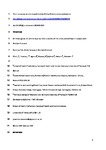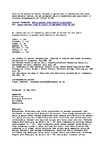An investigation of commonly prescribed stretches of the ankle plantarflexors in people with Multiple Sclerosis
| dc.contributor.author | Ofori, J | |
| dc.contributor.author | Freeman, Jennifer | |
| dc.contributor.author | Logan, A | |
| dc.contributor.author | Rapson, R | |
| dc.contributor.author | Zajieck, J | |
| dc.contributor.author | Hobart, J | |
| dc.contributor.author | Marsden, Jonathan | |
| dc.date.accessioned | 2016-06-30T07:36:58Z | |
| dc.date.issued | 2016-08 | |
| dc.identifier.issn | 0268-0033 | |
| dc.identifier.issn | 1879-1271 | |
| dc.identifier.other | 0 | |
| dc.identifier.uri | http://hdl.handle.net/10026.1/4986 | |
| dc.description.abstract |
BACKGROUND: Stretches are often prescribed to manage increased limb stiffness in people with Multiple Sclerosis. This study determined the ankle plantarflexor torque magnitude that people with Multiple Sclerosis can apply during four commonly prescribed stretches and determined the relationship between the applied torque and functional ability. METHODS: People with Multiple Sclerosis (N=27) were compared to healthy control participants (n=15). Four stretches were investigated; stretching in step standing; using a step; pulling the ankle into dorsiflexion and standing in a frame. Joint position and forces were measured using 3D motion analysis and torque transducers. Baseline ankle strength and stiffness was measured using motor driven ankle perturbations. FINDINGS: People with Multiple Sclerosis (N=27) had higher stretch reflex amplitudes and lower strength compared to the control group (n=15). People with Multiple Sclerosis achieved less lengthening of the plantarflexor muscle-tendon complex when stretching but similar ankle torques compared to controls. While stretching people with Multiple Sclerosis showed greater muscle activation in the ankle plantarflexors. Stretches in weight bearing positions produced higher plantarflexor torques. People with Multiple Sclerosis with lower functional ability preferred the more supported stretches (ankle pull and standing frame). INTERPRETATION: Stretches in weight bearing positions achieve higher ankle torques but this is in part due to increased postural activity in people with Multiple Sclerosis. Functional ability may limit stretch effectiveness. | |
| dc.format.extent | 22-26 | |
| dc.format.medium | Print-Electronic | |
| dc.language | en | |
| dc.language.iso | en | |
| dc.publisher | Elsevier | |
| dc.relation.replaces | 10026.1/5403 | |
| dc.relation.replaces | http://hdl.handle.net/10026.1/5403 | |
| dc.subject | Stretching | |
| dc.subject | Multiple Sclerosis | |
| dc.subject | Stiffness | |
| dc.subject | Spasticity | |
| dc.title | An investigation of commonly prescribed stretches of the ankle plantarflexors in people with Multiple Sclerosis | |
| dc.type | journal-article | |
| dc.type | Journal Article | |
| plymouth.author-url | https://www.webofscience.com/api/gateway?GWVersion=2&SrcApp=PARTNER_APP&SrcAuth=LinksAMR&KeyUT=WOS:000382798500004&DestLinkType=FullRecord&DestApp=ALL_WOS&UsrCustomerID=11bb513d99f797142bcfeffcc58ea008 | |
| plymouth.issue | 0 | |
| plymouth.volume | 37 | |
| plymouth.publication-status | Published | |
| plymouth.journal | Clinical Biomechanics | |
| dc.identifier.doi | 10.1016/j.clinbiomech.2016.05.013 | |
| pubs.merge-from | 10026.1/5403 | |
| pubs.merge-from | http://hdl.handle.net/10026.1/5403 | |
| plymouth.organisational-group | /Plymouth | |
| plymouth.organisational-group | /Plymouth/Faculty of Health | |
| plymouth.organisational-group | /Plymouth/Faculty of Health/Peninsula Medical School | |
| plymouth.organisational-group | /Plymouth/Faculty of Health/School of Health Professions | |
| plymouth.organisational-group | /Plymouth/REF 2021 Researchers by UoA | |
| plymouth.organisational-group | /Plymouth/REF 2021 Researchers by UoA/UoA03 Allied Health Professions, Dentistry, Nursing and Pharmacy | |
| plymouth.organisational-group | /Plymouth/Research Groups | |
| plymouth.organisational-group | /Plymouth/Research Groups/FoH - Applied Parkinson's Research | |
| plymouth.organisational-group | /Plymouth/Research Groups/Institute of Health and Community | |
| plymouth.organisational-group | /Plymouth/Research Groups/Institute of Translational and Stratified Medicine (ITSMED) | |
| plymouth.organisational-group | /Plymouth/Research Groups/Institute of Translational and Stratified Medicine (ITSMED)/CCT&PS | |
| plymouth.organisational-group | /Plymouth/Research Groups/Plymouth Institute of Health and Care Research (PIHR) | |
| plymouth.organisational-group | /Plymouth/Users by role | |
| plymouth.organisational-group | /Plymouth/Users by role/Academics | |
| plymouth.organisational-group | /Plymouth/Users by role/Researchers in ResearchFish submission | |
| dc.publisher.place | England | |
| dcterms.dateAccepted | 2016-05-18 | |
| dc.rights.embargodate | 2017-6-1 | |
| dc.identifier.eissn | 1879-1271 | |
| dc.rights.embargoperiod | 12 months | |
| rioxxterms.versionofrecord | 10.1016/j.clinbiomech.2016.05.013 | |
| rioxxterms.licenseref.uri | http://www.rioxx.net/licenses/under-embargo-all-rights-reserved | |
| rioxxterms.licenseref.startdate | 2016-08 | |
| rioxxterms.type | Journal Article/Review |



